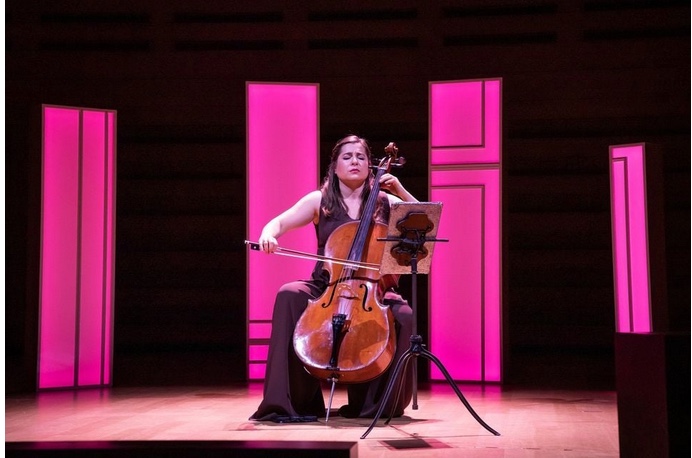by Stephanie Manning

The cellist’s concert at Severance Music Center on May 11, FRAGMENTS 1, defied many traditions of a solo recital. Audience members gathered knowing the project’s basic conceit — that the evening would feature movements from J.S. Bach’s Cello Suite No. 1 interspersed with works by 5 of the 27 composers Weilerstein commissioned for this multi-year project. But the specifics of which music would be heard, and when, remained a secret until the programs were distributed at the concert’s conclusion.
The point of it all was to increase the listeners’ dedication to, well, listening — as opposed to burying their nose in program notes that would preempt their reactions to what they were about to hear. In the spirit of the event, I put down my pen and paper and kept all my attention on the stage.
Not that I could have written much of anything legibly, anyway. With the house lights in Mandel Concert Hall completely dark, all sightlines zeroed in on Weilerstein, who sat surrounded by a semicircle of rectangular boxes of various sizes. Each new piece also cued a lighting change — whether in color, intensity, or both.
The word “fragments” can imply many things, but the performance was anything but choppy and disjointed. With her powerful, rich, and sensitive sound, Weilerstein adapted easily to both contemporary and Baroque demands. The cellist played for 65 minutes without intermission, making the arrangement of pieces come together as a single event. After a reflective movement of Bach, she would pause for just a few seconds before launching into something new — anything from neo-Romantic to contemporary with extended techniques.
At the April performance of FRAGMENTS 1 in New York City, journalists were asked to provide a spoiler warning before revealing the program. So for those who want to keep the element of surprise: skip to the second-to-last paragraph. But for the curious, there were plenty of names familiar to The Cleveland Orchestra — like Allison Loggins-Hull, the current composer-in-residence, and Joan Tower, whose cello concerto was performed by Weilerstein and the Orchestra in 2021.
Selections by Loggins-Hull and Reinaldo Moya inspired the cellist’s most ferocious playing, while more delicate ones from Gili Schwarzman and Chen Yi invited moments of calm. The Bach, meanwhile, retained a rich depth, even if it did occasionally lose some of its meditative quality. But perhaps that was inevitable in this changed context.
Extra-musical elements may seem gimmicky to some classical music traditionalists, but the stage setup proved intriguing. Some choices were a bit unclear — like the specific mention of a costume designer, despite Weilerstein remaining in the same dark brown dress all evening. And whether the rectangular boxes had a purpose other than reflecting light was also up for interpretation. The lighting design by Seth Reiser, however, was easily the most engrossing element — aside from the music, of course.
Composers were represented by color schemes, including a light green, a red-yellow blend, and some subtle neutral shades. Bach inspired an intense white light, functioning almost as a North Star for the direction of the program. And as the final note of the Prelude rang out, the lights dimmed to black. Detailed programs awaited us listeners in the lobby — here, the end was just the beginning.
Published on ClevelandClassical.com May 17, 2022.
Click herefor a printable copy of this article


